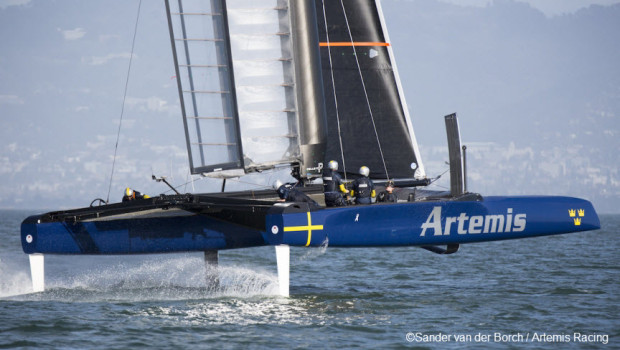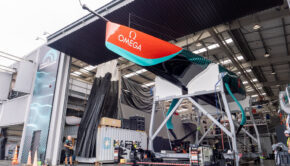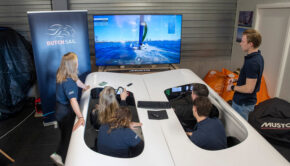America’s Cup: Adjusting the balance
Published on March 27th, 2015
It is hard to argue that the America’s Cup is fueled as much by controversy as competition. The latest dispute surrounds the AC62, which was revealed in June 2014 as the platform to be used in the 2017 event. But now there is a proposal to reduce the boat size, perhaps between 45 to 50 feet.
Among the five challengers, the Italian team Luna Rossa Challenge, is distinctly opposed to the proposal, and threatening to withdraw from the America’s Cup, Scuttlebutt editor Craig Leweck spoke with Defense CEO Russell Coutts for an update:
What are the factors behind this proposal to downscale the boat?
A lot was learned this past February, when Oracle and Artemis were sailing their modified AC45 turbo sport boats on San Francisco Bay. These were launched as design test platforms, but when you look at the video images, we found the boats to be presenting well on camera, which is where most of your sponsorship value lies. We also saw them going basically the same speeds as the AC72s, and this was just after launching them. Plus they have improved maneuverability than the bigger boat.
(Editor’s note: Here are photos and videos of the AC45 Turbo: 1 – 2 – 3 – 4 – 5)
So to downscale the boat, we would not be giving up much visually, and there would be significant cost savings. This change would have an immediate impact. We are currently going through the final entry process. We look to already have one additional challenger from Asia, and if we downscale the boat we might possibly have two additional teams, plus it would allow the French team to have a competitive budget.
There’s probably no question that the bigger boats are grander, and in some ways more spectacular, but one of the great lessons from the last America’s Cup Final was that if we can have close racing amongst good teams, than that becomes more of the focus.
When you look at all the factors, the argument to move away from a larger platform becomes pretty compelling. It is unfortunate that Luna Rossa does not see it this way, and seeks to make no changes, which in our view is to keep the cost of the competition high. Yes, we made some progress when we conceived the AC62, but nothing like if we further downscaled the size of the boat.
During the build-up toward the 34th America’s Cup in 2013, it was widely agreed that the AC72 was too expensive and complex, and did not need to be as big to gain attention. But a lot now has transpired. Foiling is more commonplace. Won’t a significant downscale of the boat impact the uniqueness and allure of the America’s Cup?
That has been the concern, but what has my attention is how to get more competitive teams into the game rather than to have something more dramatic. Let’s consider the Deed of Gift match between our team and Alinghi in 2010. These were massive boats, and they were clearly spectacular as a result of their size. But that’s not enough to hold your interest for very long as the racing for the most part was not very compelling.
We saw with the AC72s that they succeeded in providing for compelling racing, but if we stayed with the AC72s, we most certainly would have had less teams. The complexity of the bigger boats cannot be overstated, so it is quite hard to be competitive. This leads to dull races.
But what we did learn from the AC72s is how much we didn’t expect. The ability for them to foil, and then foil through the gybes. It was all quite amazing. And when the roll tacking was perfected it was game changing.
I am pretty sure that nobody had the full picture of what racing the AC72s would be like when we started, and I am not sure if we know where the ceiling is now. However, what we do know is that these new modified AC45 turbo sport boats that we sailed in February have already proven to be quite remarkable, and if we downscaled from the AC62 so more teams can compete, and compete well, then that would produce an even more compelling regatta.
It is notable how much has taken place in the past nine months. When we took a vote then amongst the teams to downscale the boat, only two teams were in favor, with the others sharing the same concerns that are being voiced today by the fans. The teams feared the change might diminish the appeal of the Cup. But now nearly all the teams are looking at the proposition differently after having seen some of the more modern boats that have been launched.
So if we stop right now and develop a new rule around a downscaled boat, there is a belief that the racing will be just as compelling, particularly if you had additional teams, and that these teams could be competitive as a result of the rules getting tightened up.
I suspect that Luna Rossa is opposed to this initiative because they feel they have a competitive advantage if we stay with the bigger boat. I personally don’t believe that is true, and that their skills will be equally applied at a smaller scale. I think, regardless of the boat size, it will be the same factors that will lead to winning or losing the America’s Cup. It will just cost more money to do it at the bigger scale, and that to me doesn’t seem very logical.
How do you balance lowering the cost to compete and having quality competition?
What we don’t want are teams that aren’t competitive. When China competed in the 32nd America’s Cup in Valencia, they weren’t very competitive, and I will argue that their effort may have done more harm than good for the growth of Chinese sailing. It certainly did not help.
But the French team that’s now entered is an example of what we do want. Given their history, they have every right to be a competitive team. But the current plan, with its expected budget, might not allow for them to be competitive.
So we need to find a balance. We want it to be at a cost basis that is sensible for these teams and a complexity basis that is within their reach. Clearly, at the bigger scale of boat, it is costing too much. I think even Luna Rosa team owner Patrizio Bertelli would agree. But also at the bigger scale, the complexity of the boat, the ability to build them, is too difficult. It is out of balance.
So to downscale the boat, it can dramatically improve two entry hurdles. And in a way, we do want to make it more about the sailing, and not so much about who has the most money. We do want to make it more about the best sailors and not about the best budget. So that is the direction behind the current thinking.
Regarding the cost to compete, by downscaling the boat, you reduce construction costs and team size, which is critical since salaries are the most significant budget line item. But when your team was reportedly prepared to pay over $300,000 a year for a grinder, what about imposing limits on each person’s salary?
I agree that each sailor’s salary must fit into the scope of the America’s Cup. I would certainly be in favor of a salary cap or some sort of rule in that area, but what complicates the issue is the international nature of the America’s Cup. If you were administering a sports league, you tend to be doing it within a country or continent. For those leagues that impose a salary cap, it is relatively straight forward to factor compensation around the other variables. But once you apply that equation to a global landscape, it becomes a lot more difficult.
I am not saying that it’s impossible, but it is challenge and it is one of the differences the America’s Cup faces when compared to other sports leagues that tightly control their player salaries. But given all that, looking at limiting sailor salary needs to be considered in the future, but I am not so sure it is as simple as one might suspect. I am not saying there isn’t a solution, but the concept is not without its issues.
The Italians are digging in with their opposition to downscaling the boat. Do you think they will withdraw?
That is certainly what they are saying. It is notable that if we look back a few months, when the Luna Rossa team became Challenger of Record, they sought to change the process because they viewed it was wrong, and that decisions needed more of a consensus view. Therefore the process was changed to reflect this. The Protocol was changed such that the Challenger of Record does not have veto power, and that they would go along with the majority of votes among the challengers. So that’s what they did a few months ago, but now they seem to be saying that they only want consensus if they agree with it. So I am hopeful they change their view again.
It certainly is important to keep Luna Rossa in the game, no doubt about it, but it is also important to keep the French and the Asian teams in the game as well. The bottom line is that we don’t see the sense in spending a lot of money this time by using a boat where the cost basis is too high for this to work. To put it in perspective, we don’t see the sense in building all these AC62s for the 35th America’s Cup when we already anticipate that they won’t be used again after this edition. We firmly contend the boat is wrong to grow the Cup based on its expense and ability to attract qualified teams.
We did try to get ahead of this issue earlier but did not have sufficient support to downscale the boat at the time. And the concerns were valid then, as people were cautious that a smaller boat might risk losing the elements that make winning the America’s Cup an elite and prized accomplishment. But we also recognize that the America’s Cup must be something sought after, that enough people want to take on the challenge.
As a defender, we got criticized for that when we changed to the AC72, and there was certainly some bad racing in 2013 as a result. So we are certainly of the mind that it is too expensive to compete and we do need to bring down the costs, not only now but for the future. It is just a huge waste of money to build all these AC62s when clearly it is not working now, and there is no reason to believe it will work in the future.
Will downscaling the boat impact the competition structure?
The Protocol calls for the first round of racing, called the America’s Cup Qualifiers, to be held at a separate location from Bermuda, but what we are proposing now with the smaller boat is for all the racing aside from the AC World Series to be in Bermuda. Moving between locations had been a concern, so this benefits the teams in both cost savings and lost time.
Looking forward, if we downscaled the boats, it would open up the possibility in future America’s Cup editions of having events in multiple venues around the world. These boats would be a lot more transportable. But for this edition, the AC World Series will remain in the AC45 with foils as has previously been agreed, and then we would use the downscaled boat in 2017 beginning with the AC Qualifiers and then through to the AC Match.
Editor’s note: The teams will be asked to vote on rule changes to the boat before the end of March, with only a majority vote required to make the change. At this stage we can assume the Italians and Team New Zealand will vote against the proposal. Here is what the Kiwis team is saying:









 We’ll keep your information safe.
We’ll keep your information safe.